Abstract
As an unconventional oil and gas reservoir, helium gas reservoirs have gradually become a focus of attention. In recent years, with the continuous increase in demand for helium gas, the uneven distribution of global helium resources has attracted China’s attention to helium resources. In this study, a method for predicting favorable areas of helium gas was proposed based on the natural gas exploration theory and the idea of “finding gas in enrichment areas”. We conducted an in-depth study and analysis of the types of helium gas formations in China by comprehensively using geochemical and isotope-testing data, identifying the distribution of helium source rocks in China. Based on this, we conducted directed analyses of the transport channels and caprock conditions for helium gas, and summarized the enrichment modes of helium gas. Using this method, we predicted five favorable areas for the enrichment of helium gas in China, providing an important basis for the future exploration and development of helium resources in China.
1. Introduction
Unconventional oil and gas reservoirs are currently a key area of oil and gas development worldwide, and in recent years, helium gas reservoirs have become a new hot spot in this field. Research on helium gas dates back to the 1930s, and there have been various opinions regarding its source. Ruedemann [1] believed that the helium gas in the Panhandle, which is a large and rich helium gas field in the United States, primarily originated from the decay of U and Th in granite and pegmatite in the reservoir. Pierce [2] believed that helium gas originates from source rocks, while Katz [3] believed that helium gas comes from sedimentary rocks containing ammonium minerals and organic matter. However, Nikonov [4] believed that helium gas originates from the crust, and Maione [5] believed that helium gas comes from the basement. Gold [6] and others inferred that helium gas is generated jointly from basement rocks and basement source rocks. Currently, scholars believe that helium gas primarily originates from deep mantle-source fluids and the decay of U and Th in granitic rocks.
In addition to identifying the source of helium, it is also necessary to determine the transport pathways and migration modes of helium gas during the accumulation process. Different scholars have proposed various viewpoints regarding the transport modes and pathways of helium gas. Some scholars believe that helium gas is transported through diffusion, and can also be upwardly transported with fluids [7]. Other scholars propose that the main pathways for helium gas are basement faults and fractures [4,6,8]. Studies by Ballentine [9] and Brown [10] suggest that the helium gas in the Panhandle gas field is transported via groundwater. Qin [11] and colleagues suggest that in the Weiyuan gas field, helium gas is dissolved in water before degassing and accumulation. In the research conducted by Zhang [12] and his team, they suggest that helium gas generated from radioactive minerals initially dissolves in water, and then dissolves in a carrier gas before being transported into the reservoir.
For a long time, China has relied heavily on imports to obtain sufficient amounts of helium gas, as its own production and resource reserves are very inadequate. This situation is mainly due to the past underestimation and neglect of helium resources in China, which prevented adequate exploration and development work from being carried out. In addition, the incomplete theories on the formation of helium reservoirs have further hindered the exploration and development of China’s helium resources. Therefore, it is necessary to predict the favorable areas for helium gas in China to provide a sufficient theoretical basis for finding and developing helium resources.
2. Global Helium Situation
2.1. Global Distribution of Helium Resources
The global distribution of helium gas is uneven, and according to a report from the US Geological Survey in 2023 [13], the average recoverable helium reserves in known natural gas reservoirs in the United States is 8.49 × 109 m3. Except for the United States, the estimated global helium resources are about 3.13 × 109 m3. They are in Qatar with 10.1 × 109 m3, Algeria with 8.2 × 109 m3, Russia with 6.8 × 109 m3, Canada with 2.0 × 109 m3, and China with 1.1 × 109 m3, indicating the extremely uneven distribution of global helium resources. Overall, the world’s proven and remaining helium reserves are gradually decreasing, but at the same time, some large helium fields have been discovered. For example, the “world-class” helium field discovered in the East African Rift Valley in Tanzania is estimated to have reserves of up to 2.8 × 109 m3 [14].
According to the US Geological Survey and Danabalan’s article on the distribution of helium gas in the United States, the helium resources of the United States are mainly distributed in the Panhandle-Hugoton gas field in Kansas, Oklahoma, and Texas, the Riley Ridge gas field in Wyoming, the Greenwoods gas field in Kansas, the Keyes gas field in Oklahoma, and the Cliffside gas field in Texas. In addition, some helium-rich natural gas resources have also been discovered in sedimentary basins to the east of the Rocky Mountains and in New Mexico (Figure 1) [8,15,16].
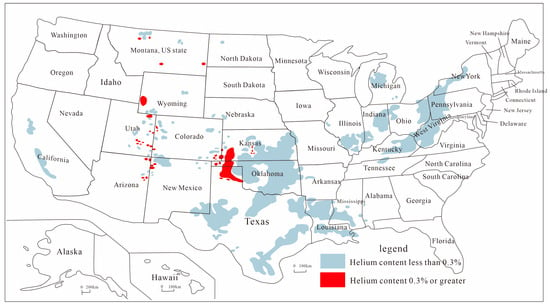
Figure 1.
Distribution of helium resources in the United States (from Danabalan D. 2017 [16]).
According to Akutsent’s research in 2014, it was found that the helium resources discovered in Russia are mainly distributed in natural gas fields on the West Siberian Plateau. In addition, there are also some helium-rich natural gas fields in the Orenburg field in the Northern Caspian region, the Chayanda gas field in the Yakutia region, and some areas in the Irkutsk region and Komi Republic (Figure 2) [17]. From the distribution maps of the helium contents in the United States and Russia, uneven distributions also occur within these countries.
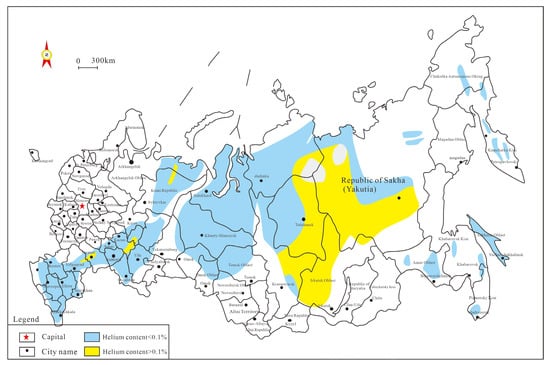
Figure 2.
Distribution of helium resources in Russia (from Akutsent V.P. 2014 [17]).
2.2. Global Helium Supply and Demand
In 2021, the helium production capacity in the United States was about 77 million cubic meters, accounting for about 48.13% of the global production, while Qatar’s production capacity was about 51 million cubic meters, accounting for about 31.88%. Together, their production capacity accounts for almost 80% of the global production, while China only accounts for about 0.63%. Helium resources are almost completely owned by a few countries such as the United States and Qatar [18].
The United States is the world’s largest producer and supplier of helium. Prior to 1996, 90% of the world’s helium production came from the United States. After 2000, most of the helium-rich natural gas fields in the United States entered a depletion phase of development. Since 2012, US helium production has been declining at an annual rate of about 10%. Since 2005, the helium production in Qatar has rapidly increased to 5 × 107 m3 after being put into operation. As Qatar, Algeria, and other countries increased their helium production, the proportion of US helium production in the global total decreased from 90% in the 1990s to 55% in 2016. Among the global helium production proportions, Qatar accounts for 32%, Algeria for 6.5%, Australia for 2.6%, Russia for 1.9%, and Poland for 1.3% (Figure 3) [14].
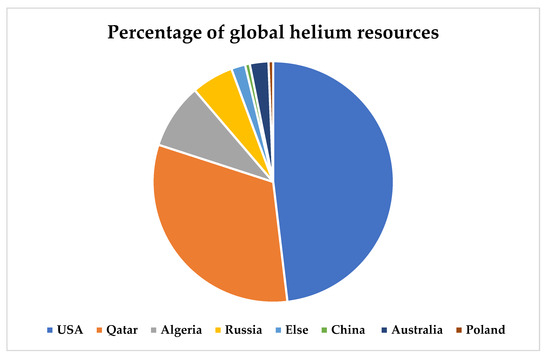
Figure 3.
Pie chart showing the proportion of global helium production capacity.
Due to the impact of the reduction in US helium production, the global helium supply has been in an overall downward trend since 2013. As the economy and high-tech industries continue to develop rapidly, the application scope of helium has gradually expanded, and global helium demand is growing at an annual rate of 4% to 6% [19]. This has led to a current supply shortage of helium, which is expected to last for a long time.
In 2016, the global helium demand was 2.3 × 108 m3, but the annual production was only 1.54 × 108 m3. According to the United States Geological Survey, the global helium resource amount was approximately 520 × 108 m3 in 2020, of which the United States accounts for about 206 × 108 m3, followed by Qatar with a helium resource reserve of about 10 × 108 m, while China’s helium resource amount is about 11 × 108 m3, accounting for only 2% [13].
China’s demand for helium was very small prior to 1990, and the highest production of helium before 1989 was only 3 × 104 m3 [20]. In 2005, China imported 2 × 106 m3 of helium, and by 2012, the total amount of imported helium had reached 5 × 106 m. In 2017, China imported approximately 20 × 106 m3 of helium [21], which means that the amount of imported helium has increased by 10 times that amount in just 10 years. Currently, China’s helium supply is heavily dependent on imports, mainly from Qatar, the United States, and Australia, so the situation for helium resources in China is very severe.
3. Materials and Methods
Based on natural gas exploration theory and the “finding gas in enrichment zones” concept, this article proposes a method for predicting favorable areas for helium gas exploration. The Combination of Functional Elements to Control Reservoir Formation Method (CPH) involves using three functional elements, including the caprock (C), effective migration pathway (P), and helium source rock (H). With the distribution and development of CPH, this method predicts favorable areas for the enrichment of helium in China. Using the helium content of discovered oil and gas reservoirs, the rationality of the subdivision scope of the predicted favorable areas has been confirmed.
We reprocessed the geological, geochemical, and isotopic data of nine samples collected from seven regions, conducted an in-depth analysis, and studied the types of helium gas geneses in China. Through this analysis, we discovered the laws governing the sources of helium gas and the distribution patterns of helium source rocks in China. We also conducted directional analyses of the migration pathways and caprock conditions for helium gas, and summarized the enrichment patterns of helium gas. Based on these findings, we predicted favorable areas for helium gas exploration and verified their rationality using the helium content of discovered oil and gas reservoirs. This study provides an important foundation for the future exploration and development of China’s helium resources. The research outcomes of this study hold significant practical and theoretical implications, which will promote the development and utilization of helium resources.
4. Results
4.1. Genetic Types and Distribution Characteristics of Helium in China
4.1.1. Types of Helium Geneses
Helium gas in natural gas reservoirs has various sources and origins. The origin and source of helium can be effectively identified using the composition of helium and rare gas isotopes. Helium has two stable isotopes, 3He and 4He. 3He is mainly derived from mantle degassing, while 4He is mainly derived from the decay of radioactive elements like 238U, 235U, and 232Th. The main radioactive decay reactions are as follows [19]:
238 U→8 4He + 6β + 206Pb
235 U→7 4He + 4β + 207Pb
232 Th→6 4He + 4β + 208Pb
The classification of helium gas origin types is determined by isotopic ratios. The isotopic signature of the sample helium is expressed as the 3He/4He ratio (R) relative to the atmospheric helium 3He/4He ratio (Ra), to determine the helium isotope characteristics of the gas sample.
R/Ra = (3He/4He) sample/(3He/4He) atmosphere
In natural gas reservoirs, the composition of atmospheric helium is so small that it can be neglected. Therefore, the source of atmospheric helium can be ignored, and a binary composite model can be used to calculate the proportions of crustal and mantle helium in natural gas samples. When the isotopic ratio R/Ra is used to express the isotopic distribution characteristics of the gas sample, if (R/Ra) > 3.94, then the proportion of mantle helium is greater than 50%; if (R/Ra) > 0.1, then the proportion of mantle helium is greater than 1%; if (R/Ra) < 0.1, then it is from crustal sources [11]. Mantle-source helium gas will ultimately enter crustal reservoirs and become accumulated. Therefore, mantle-source helium-rich natural gas reservoirs are always mixed with crustal-sourced helium gas.
Cao, Z.X. (2001), Guo, N.F. (1999), Dai, J.X. (2003), Yu, Q.X. (2013), and Zhang, X.B. (2020) [12,22,23,24,25,26,27,28] collected natural gas samples from the Hankou Gas Field and the Huangqiao Gas Field on the Tan-Lu Fault, the Wanjinta Gas Field in the Songliao Basin, the Weiyuan Gas Field in the Upper Yangtze Plate, the Yakra Gas Field and the Hetianhe Gas Field in the Tarim Plate, and the Mabei, Dongping, and Niudong areas in the Qaidam Block, respectively, and analyzed their natural gas components using mass spectrometry. We reprocessed the test result data (Table 1). We found that helium gas is produced along with natural gas in gas reservoirs. Helium-rich gas reservoirs with a crustal origin are mainly composed of organic (CH4) gas reservoirs. Helium-rich gas reservoirs with a mantle origin are characterized by a high content of nitrogen gas. The helium-rich natural gas can be classified into organic helium-rich gas reservoirs and inorganic helium-rich gas reservoirs based on its geochemical composition. From a geological structural perspective, the mantle-origin helium-rich gas reservoirs are mainly distributed in fault zones, where there is no supply of hydrocarbon source rocks for the reservoirs, but the tectonic activity is strong and the faults are well developed. The helium gas reservoirs with a crustal origin are generally associated with natural gas and are distributed along the edges of tectonic plates.

Table 1.
Composition and Isotopic Characteristic Data Table of Natural Gas Reservoirs.
4.1.2. Genetic Types and Distribution Characteristics of Helium in China
We conducted an investigation and analysis of eight basins in China. Xu, Y.C. (1997) [24], Yu, Q.X. (2013) [22], DAIJ. X. (2005), He, F.Q (2022) [30], Cao, Z.X. (2001) [26], Guo, N.F. (1999) [27], Zhang, Y.P (2016) [31], HAN W. (2020) [32] and others collected samples from oil and gas reservoirs in the Tarim Basin, Qaidam Basin, Junggar Basin, Sichuan Basin, Songliao Basin, Bohai Bay Basin, Subei Basin, and San-shui Basin, respectively, and conducted a helium isotope analysis of their natural gas using a mass spectrometer. We have summarized their analysis results in Table 2. There are significant differences in the helium isotopic ratios and mantle-source helium proportions among the helium-bearing basins in China. According to the research data analyzed in this paper, the 3He/4He values were found to range between 1.01 × 10−8 and 7.2 × 10−6, and the R/Ra values were found to range between 0.01 and 5.14. In China, the helium-bearing basins with high mantle-source helium proportions are mainly distributed in the eastern part of the country. Among them, the Sanshui Basin shows a strong correlation between its helium content and mantle-source helium proportion. The input of mantle-source helium is the main reason for the high helium content in the Sanshui Basin and other eastern basins in China. Except for some samples from the Junggar Basin and Tarim Basin, the R/Ra values of samples from the central and western basins in China were mostly lower than 0.1, indicating that the mantle-source helium proportions were less than 1.1%, and almost all the helium gas was derived from crustal sources.

Table 2.
Statistical table of helium characteristics in basins in China.
The Tarim Basin is the largest onshore oil and gas basin in China, and is a large cratonic basin developed on the Precambrian basement. The 3He/4He values in the basin were found to range between 1.92 × 10−8 and 2.6 × 10−7, and the R/Ra values were found to range between 0.014 and 0.186, indicating that the helium gas is predominantly derived from crustal sources. The Qaidam Basin is a large-scale cratonic-type oil and gas basin in western China, with a complex fault system and Precambrian metamorphic rocks and Hercynian granites as the basement of its northern margin. Helium isotope ratios in the basin range from 1.01 × 10−8 to 1.3 × 10−6 for 3He/4He values and from 0.007 to 0.93 for R/Ra values, indicating that most of the helium in the basin originates from a crustal source. The Junggar Basin is a large oil and gas basin in northwest China that has undergone multiple tectonic events. The 3He/4He values in the basin were found to range from 1.96 × 10−8 to 5.4 × 10−7, while the R/Ra values were found to range from 0.014 to 0.386. The helium in the basin is mostly derived from crustal sources, with only a small amount of mantle-source helium mixing occurring in the southern sag area. The Ordos Basin is a large-scale oil and gas basin developed on the craton basement. The 3He/4He values in the basin range from 2.07 × 10−8 to 13.64 × 10−8, and the R/Ra values vary between 0.01 and 0.1, indicating that the helium gas in the basin is mostly derived from crustal sources. The basement of the Sichuan Basin is composed of magmatic and metamorphic rocks, and the Weiyuan gas field, which belongs to the Cambrian gas reservoirs, was the first commercial helium production area in China. The 3He/4He values in the gas field range from 1.4 × 10−8 to ~5.74 × 10−8, while the R/Ra values are between 0.01 and 0.04, indicating that crustal helium is the main source of helium in the Weiyuan gas field. The Songliao Basin is a Cenozoic continental extensional rift basin with a large-scale intrusion of granites in the basin. The 3He/4He values in the basin are distributed within the range of 1.01 × 10−6 to 7.2 × 10−6, while the R/Ra values are between 0.72 and 5.14, indicating that the helium gas in the basin is mainly derived from a crustal source. The Bohai Bay Basin is a typical inland rift basin that contains six sag basins and has experienced multiple magmatic activities. The 3He/4He values in the basin are distributed in the range of 8.97 × 10−7 to 5.22 × 10−6, while the R/Ra values are between 0.64 and 0.73. Due to the influence of magmatic and fault activities, a large amount of mantle-derived helium has entered the basin, making it a mixed type of crust-mantle helium. The main tectonic pattern of the Subei Basin consists of “one uplift and two sag basins”. The 3He/4He values in the basin are distributed in the range of 3.71 × 10−6 to 5.54 × 10−6, while the R/Ra values are distributed between 2.63 and 3.96, indicating that the helium gas in the basin is a typical mixture of crust-mantle sources.
Based on the above data, we have found that the helium reservoirs in western China are mainly located in the Sichuan, Tarim, Qaidam, and Junggar basins, as well as south of the Weihe River Fault, with the crustal source being the primary source of helium. In the eastern region, helium is mainly located in the oil and gas-bearing basins on both sides of the Tan-Lu fault zone, such as the Subei, Songliao, Hailar, Bohai Bay, and Sanshui basins, and is mostly of a mixed crust-mantle origin, with the mantle source being the dominant source (Figure 4).
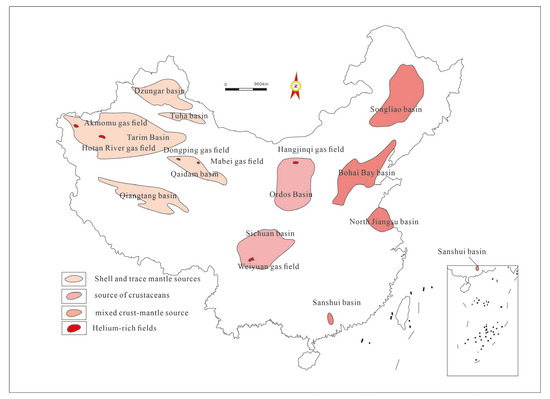
Figure 4.
Genetic types of helium gas in major petroliferous basins in China.
4.2. China’s Helium Accumulation Conditions and Enrichment Patterns
Under the guidance of the theoretical and enrichment zone concepts in natural gas exploration, we believe that research on the accumulation conditions of helium in China is essential. By studying the helium source rocks, migration pathways, and sealing layers in China, we can understand how helium gas is enriched in different regions of the country. This research also provides the basis for predicting the distribution of favorable areas for helium in China.
4.2.1. Distribution Characteristics of Helium Source Rocks
Research on the genesis of helium types has shown that most basins in China have crustal sources of helium, and the helium source rocks in China are mainly rich in uranium-containing granites in the crust. These types of rocks are mainly distributed in tectonic-magmatic activation zones on the edges of cratons, fold belts in orogenic zones, and active continental margins. The fold belts on the edges of cratons generally developed along the margins of the Archean continental nucleus and later underwent strong folding, metamorphisms, and granite transformations to form these rocks. After multiple tectonic movements in large orogenic belts, basement rocks and granites with a high uranium content are the main helium source rocks. Based on the above conditions, we conducted a survey of the strata in China and drew a distribution map of the helium source rocks in China.
According to the distribution of helium source rocks in China (Figure 5), the main distribution areas of helium source rocks in China are mainly in the southeast of South China, the northern part of the Qinling Mountains, the eastern part of Tibet, the Tianshan Mountains, the Yin Mountains, and the northern part of the Greater Khingan Mountains. They are also distributed in Western Sichuan, the southern part of the Qaidam Basin, the western Kunlun Mountains, Qilian Mountains, Greater Khingan Mountains, Eastern Liaoning, and Erguna. This also indicates that the research on the distribution of helium source rocks is the basis for predicting the distribution of favorable areas for helium in China.
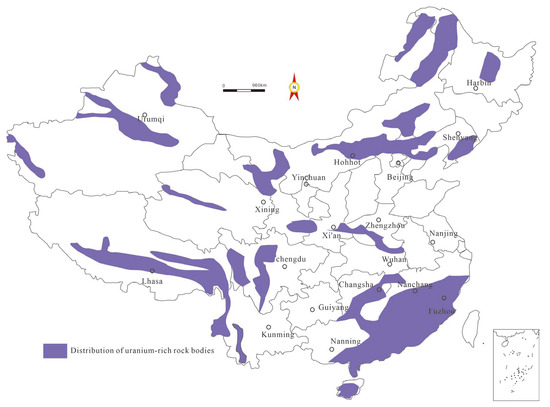
Figure 5.
The distribution map of helium source rocks in China.
4.2.2. Effective Migration Pathway in China
Transport pathways are an important part of the formation of a helium reservoir. There are two main transport pathways for helium in China. One is through major deep-seated faults, and the other is through an ancient formation of water that serves as the carrier.
The development of fault structures plays a dual controlling role in the formation of helium deposits. On the one hand, it can serve as a pathway for the upward migration of crustal-sourced helium, and on the other hand, it can serve as a pathway for the input of mantle-sourced helium [36]. The process of helium transferring from mineral particles that undergo decay to pore water is the first stage of helium transport. Then, the helium in the pore water is fractionated and extracted by the migrating gas, which contains helium gas or helium groundwater. This migrates through fractures, faults, and undergoes secondary transport until it accumulates in a structural trap, forming a helium reservoir in the geological stratum. In the crust-mantle mixed-type helium-bearing basins in eastern China, there is a strong correlation between helium gas and the Tan-Lu fault zone [37]. Research has found that areas where helium accumulates are near the Tan-Lu fault zone. According to survey data (Table 2), high helium samples from the Songliao Basin, Bohai Bay Basin, and northern Jiangsu Basin are distributed on both sides of the Tan-Lu fault zone (Figure 6), exhibiting a strong correlation. The Tan-Lu fault zone is a crustal fault that cuts through at a thickness of 30–40 km.
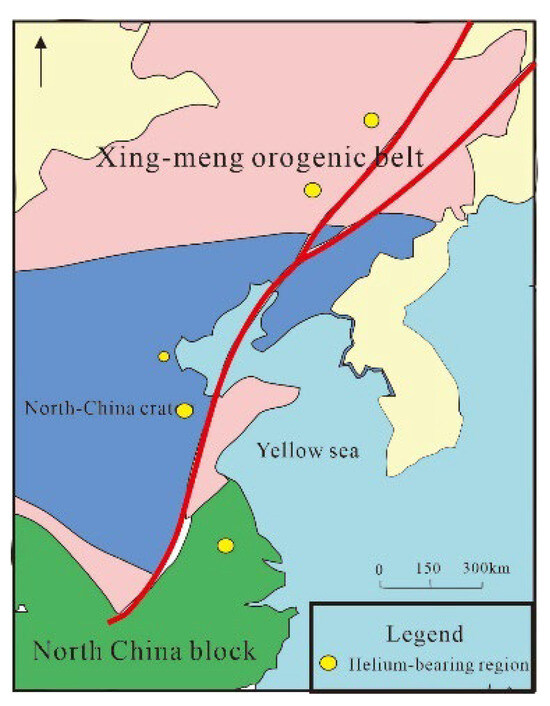
Figure 6.
Schematic diagram of the Tan-Lu fault zone and the distribution of high helium gas blocks on both sides.
Water-carried gas is the main transport pathway in the central and western regions, mainly distributed in the Sichuan Basin, the Qaidam Basin, and the Tarim Basin. Helium source rocks provide the source for helium gas generation, and the development of structural faults provides the pathway for helium gas to migrate upwards. However, the movement of helium in pore water is very slow [38,39]. Moreover, helium cannot form a separate gas stream and cannot enter a trap driven by buoyancy alone. Therefore, the large-scale migration of helium relies on groundwater and gas-bearing layers as carriers. As mentioned earlier, helium gas often accompanies the enrichment of natural gas. An analysis of the gas composition in Table 2 shows that the primary transport pathway for helium in Central and Western China is through the migration of helium in natural gas, mainly distributed in the Sichuan Basin, Qaidam Basin, and Tarim Basin.
4.2.3. Cap Rock Distribution
After helium enters a gas reservoir, if the cap rock conditions of the overlying strata are well-developed, it has the potential to become a helium-bearing gas reservoir and continuously receives replenishment of helium from the groundwater in the subsequent process. However, if the overlying strata of the gas reservoir lack cap rock conditions or the gas-bearing layer is affected by tectonic activity, the helium-bearing gas layer may migrate laterally along the geological stratum and eventually form a helium-enriched gas reservoir under suitable trap conditions.
Helium gas molecules are the smallest known chemical substance in nature, so their storage requires even stricter cap rock conditions. Helium-rich gas reservoirs are usually capped by tight anhydrite, salt rock, and shale formations [40]. Based on the distribution of helium source rocks and the lithology of cap rocks, we conducted directional and qualitative searches for cap rocks in Chinese gas reservoirs, and drew up a map showing the types and distribution of cap rocks (Figure 7).

Figure 7.
Types and distribution of cap rocks in China.
4.2.4. Chinese Model of Helium Enrichment
In the helium-rich reservoirs in central and western Chinese basins, shell-source helium is the main type of helium, and the enrichment model is mainly associated with the migration of groundwater and natural gas in the strata. Helium gas is generated by the basal helium source rocks and dissolved in ancient formation water. Due to tectonic movements, ancient formation water migrates upward along faults, releasing free helium gas along the way. The helium gas then migrates to the gas reservoirs as it moves upward. Natural gas can also serve as a carrier for helium migration. During the upward migration process of the helium-containing groundwater, if it encounters natural gas, the helium in the groundwater is displaced into the natural gas due to Henry’s Law and is carried along with the natural gas until it forms a gas reservoir in a suitable trap position (Figure 8).
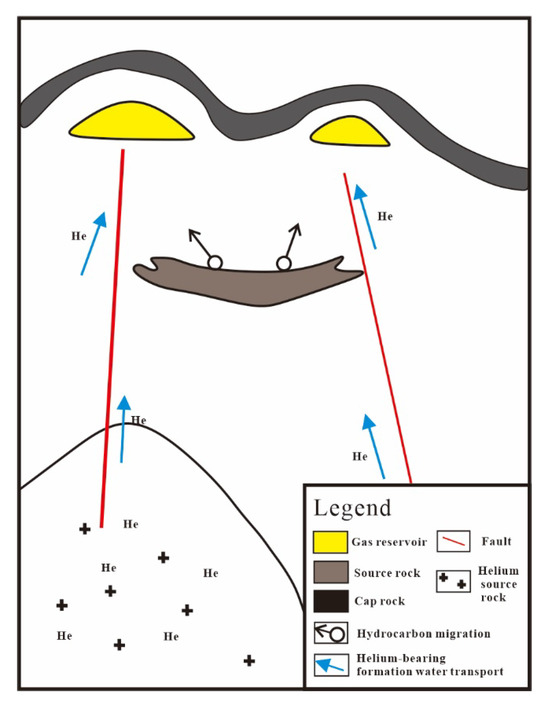
Figure 8.
Helium enrichment model in western China.
In the helium-rich reservoirs in the eastern Chinese basins, the helium is of a mantle-crust mixing origin. The thinning of the lithosphere, upwelling of the mantle, and degassing caused by magmatic activities produces mantle-source helium gas and non-organic gas (CO2, N2). More shell-source helium is released through the thermal effects of magma. The mantle-origin fluids containing helium, N2, and CO2 migrate upward along deep faults. At the same time, helium generated from other strata is also trapped in the gas reservoirs. Eventually, helium gas from different sources and natural gas combine to form a helium-rich natural gas reservoir in an appropriate trap position (Figure 9).

Figure 9.
Helium enrichment model in eastern China.
4.3. Prediction of Favorable Areas for Helium Exploration in China
Based on the distribution of helium source rocks, migration channels, and cap rocks in China, we have predicted the favorable areas for helium exploration in China (Figure 10).
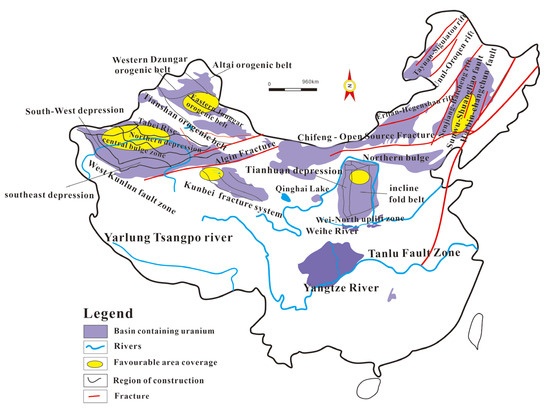
Figure 10.
Distribution of Favorable Areas for Helium Resources in China.
Permian helium source rocks are widely distributed in the Tarim Basin, appearing in areas such as Shaya, Tangguba, Shuntuoguole, and the Kongque River. In the northern part of the Tarim Basin, the Yakela structure is covered by the gypsum-mudstone segments of the Mesozoic and Cenozoic periods, which constitute the best cap rocks. The Baomashaya Uplift area in the northern Tarim Basin has good helium sources, various structural units, and cap rocks, providing favorable conditions for helium enrichment and accumulation. Therefore, it is a favorable area for helium exploration in the Tarim Basin.
Helium source rocks are well developed in both the eastern and southern parts of the Junggar Basin, mainly from the Permian and Carboniferous systems, especially in the areas of Kamsut and Kuposu. The Junggar Basin has complex tectonic activity and a NNW trending basement-deep fault zone, providing good conduit systems. Overlying the basement is Cretaceous mudstone, which forms a lithologic trap that causes the natural gas carrying the helium gas to accumulate. The Junggar Basin has excellent conditions for the generation of helium gas and has high exploration potential.
In the frontal zone of the southern Altyn Mountains in the southwestern margin of the Qaidam Basin, there are widely developed helium source rocks. The Dongping-Niudong Slope Belt has multiple north–south deep faults that serve as effective channels for the vertical transport of the helium-bearing fluid from the deep to the shallow layers. Moreover, regional gypsum salt rocks have been discovered in the northwest part of the basin, which consist mainly of gypsum-mudstone and gypsum-bearing mudstone, with a small amount of pure gypsum salt rock layers, forming excellent cap rocks. We believe that the western part of the basin is an area of excellent potential for helium gas.
The Ordos Basin experienced a large-scale granite intrusion in the Paleoproterozoic era, and the Paleoproterozoic granite in the northern region is a good source rock. There are several faults that penetrate the basement in the basin, and fractures mainly developed from the Jurassic to the early Cretaceous period, providing good conduit systems for the transport of helium from the basement. A thick layer of mudstone has developed in the northern part of the Ordos Basin, forming a high-pressure mudstone cap rock and providing conditions for the accumulation of helium. This indicates that the northern part of the basin has great potential for helium exploration and should be given special attention.
The genesis of helium gas reservoirs in eastern China is mostly from a crust-mantle hybrid source, and this method leads to errors in predicting favorable helium areas. The Songliao Basin is a continental extensional basin with active faults that have developed beneath the depression, and numerous helium sources have been discovered in this basin. A Neogene mudstone layer has developed as a cap rock in the southeastern part of the basin. Many faults have developed in the central depression and southeastern uplift zone of the basin, extending to the basement and deep mantle. These faults have a good transport capacity for helium gas and are also an important reason for the crust-mantle hybrid genesis. The central and southern parts, the southern margin, and the eastern margin of the Songliao Basin are favorable areas for helium gas accumulation.
5. Discussion
The validation method used in this paper is to confirm whether the location of the discovered helium natural gas reservoirs is within the favorable areas predicted by our method. If the location of the discovered helium natural gas reservoirs is within the predicted areas, it indicates that our method is feasible (Table 3).

Table 3.
Chinese Helium-Bearing Oil and Gas Reserve Statistical Table.
The Donghetang Oilfield in the Tarim Basin and the Hudson Oilfield have relatively a high helium content in their Carboniferous crude oil associated gas, reaching 0.40% and 0.219%, respectively [41]. The Triassic reservoirs in the Lunan and Jiefangqu oil and gas fields have a helium content of up to 0.93%. The helium content in the Carboniferous deposits in the Tazhong region ranges from 0.16% to 0.23%, while the overall helium content in the Ordovician and Silurian strata is low. The estimated helium reserve in the Tarim Basin is 1.959 × 108 m3.
The Qunjishan Gas Field in the Qaidam Basin has a tested helium content of up to 1.10%. An analysis of the dark mud shale interval of the Jurassic Daheishan Formation in the Tuanyushan Gas Field shows a helium content ranging from 0.47% to 1.14%. The estimated helium reserve in the Qaidam Basin is 4 × 108 m3.
The helium content in the central and southern depressions of the Junggar Basin is around 0.2%, specifically 0.203% and 0.236%, mainly found in the Jurassic strata. The estimated helium reserve in the Junggar Basin is 1.172 × 108 m3 [42].
The Dongsheng Gas Field and Sulige Gas Field, both located in the central part of the Ordos Basin, have indications of helium. The helium content ranges from 0.045% to 0.478% in the Dongsheng Gas Field and from 0.016% to 0.035% in the Sulige Gas Field. The estimated helium reserve in the Ordos Basin is 2.444 × 108 m3 [43].
The results of our studies have confirmed the rationality of the predicted favorable areas for helium gas exploration. The research outcomes have important implications for the exploration and development of helium gas resources in China.
6. Conclusions
We have found that the distribution of helium resources is not only uneven globally, but also imbalanced within a country. The formation process of helium is due to the decay of the U-element. In China, there are two main types of helium formation, one is the crust-mantle mixture source and the other is the crustal source. The distribution of these sources has distinct characteristics, with the mixture source located in the east and the crustal source located in the west. Based on the analysis of geology, the distribution of helium source rocks, effective transport, and cap rock distribution, we have summarized two enrichment modes. One mode involves multi-source enrichment in the east due to the crust-mantle mixture, and the other involves crustal enrichment in the west due to the accumulation of formations of water and natural gas. We predicted five favorable areas for helium accumulation, namely in the northern Tarim Basin, eastern and southern Junggar Basin, western Qaidam Basin, western Ordos Basin, and southern and eastern Songliao Basin, which were verified by the helium contents in discovered gas fields.
Author Contributions
Investigation, analysis, conceptualization, writing-original draft, Y.X.; supervision, review, S.J.; data processing, methodology, J.Y.; graphical processing, validation Y.D. All authors have read and agreed to the published version of the manuscript.
Funding
This research is funded by the Open Project of State Key Laboratory of Shale Oil and Gas Enrichment Mechanisms and Effective Development (GSYKY-B09-33).
Data Availability Statement
All data and materials are available on request from the corresponding author. The data are not publicly available due to ongoing research using a part of the data.
Conflicts of Interest
The authors declare no conflicts of interest.
References
- Ruedeman, N.P.; Oles, L.M. Helium-its probable origin and concentration in the Amarillo fold, Texas. AAPG Bull. 1929, 13, 799–810. [Google Scholar] [CrossRef]
- Pierce, A.P.; Gott, G.B.; Mytton, J.W. Uranium and Helium in the Panhandle Gas Field, Texas, and Adjacent Area. US Geological Survey Professional Papers, 1964, 454-G:1-57. Available online: https://pubs.usgs.gov/publication/pp454G (accessed on 1 February 2024).
- Katz, D.L. Source of Helium in Natural Gases: USBM Information Circular 8417; Helium Research Center Library: Amarillo, TX, USA, 1969; pp. 242–255. [Google Scholar] [CrossRef]
- Nikonov, V.F. Formation of helium-bearing gases and trends in prospecting for them. Int. Geol. Rev. 1973, 15, 534–541. [Google Scholar] [CrossRef]
- Maione, S.J. Helium exploration: A 21st century challenge. Houst. Geol. Soc. Bull. 2004, 46, 27–28,30. [Google Scholar]
- Gold, T.; Held, M. Helium-nitrogen-methane systematics in natural gases of Texas and Kansas. J. Pet. Geol. 2007, 10, 415–420. [Google Scholar] [CrossRef]
- Ballentine, C.J.; Burnard, P. Production, release, and transport of noble gases in the continental crust. Rev. Mineral. Geochem. 2002, 47, 481–538. [Google Scholar] [CrossRef]
- Broadhead, R.F. Helium in New Mexico: Geological distribution, resource demand, and exploration possibilities. New Mex. Geol. 2005, 27, 93–100. [Google Scholar] [CrossRef]
- Ballentine, C.J.; Lollar, B.S. Regional groundwater focusing of nitrogen and noble gases into the Hugoton-Panhandle giant gas field, USA. Geochem. Cacochymical Acta 2002, 66, 2483–2497. [Google Scholar] [CrossRef]
- Brown, A. Origin of helium and nitrogen in the Panhandle–Hugoton field of Texas, Oklahoma, and Kansas, UnitedStates. AAPG Bull. 2019, 103, 369–403. [Google Scholar] [CrossRef]
- Qin, S.; Yuan, M.; Zhou, Z.; Yang, J. Distribution law of helium in Leshan-Longevism paleo-uplift in Sichuan Basin, China. IOP Conf. Ser. Earth Environ. Sci. 2019, 360, 012031. [Google Scholar] [CrossRef]
- Zhang, W.; Li, Y.; Zhao, F.; Han, W.; Li, Y.; Wang, Y.; Holland, G.; Zhou, Z. Using noble gases to trace groundwater evolution and assess helium accumulation in Weihe Basin, central China. Geochem. Cosmochim. Acta 2019, 251, 229–246. [Google Scholar] [CrossRef]
- USGS. Mineral Commodity Summaries 2022. U.S. Geological Survey. 2022. Available online: http://minerals.usgs.gov/minerals/pubs/commodity/heliumn/;2022-01 (accessed on 3 February 2024).
- Tao, X.; Li, J.; Zhao, L.; Li, L.; Zhu, W.; Xing, L.; Su, F.; Shan, X.; Zheng, H.; Zhang, L. Current status of helium resources in China and the discovery of the first extra-large helium-rich reserve: Hotanhe gas field. Earth Sci. 2019, 44, 1024–1041. [Google Scholar] [CrossRef]
- Lueth, V.; Lucas, S.G.; Chamberlin, R.M. (Eds.) Geology of Geology of the Chupadera Mesa. In The 60th Annual Fall Field Conference Guidebook; New Mexico Geological Society, New Mexico Institute of Mining & Technology: Socorro, NM, USA, 2009; pp. 359–374. [Google Scholar] [CrossRef]
- Danabalan, D. Helium: Exploration Methodology for a Strategic Resource. Ph.D. Thesis, Durham University, Durham, UK, 2017. [Google Scholar]
- Akutsent, V.P. World helium resources and the perspectives of helium industry development. Pet. Geol. 2014, 9, 11. [Google Scholar] [CrossRef]
- Zhao, H.X.; Zhang, Y.; Li, C.L. Analysis of global helium supply and price system. Chem. Propellants Polym. Mater. 2012, 10, 91–96. [Google Scholar] [CrossRef]
- Wang, X.; Liu, W.; Li, X.; Tao, C.; Borjigin, T.; Liu, P.; Luo, H.; Li, X.; Zhang, J. Application of noble gas geochemistry to the quantitative study of the accumulation and expulsion of lower Paleozoic shale gas in southern China. Appl. Geochem. 2022, 146, 105446. [Google Scholar] [CrossRef]
- Feng, W.F. Economic benefit analysis of helium extraction from natural gas in Weiyuan. Nat. Gas Ind. 1989, 9, 69–71. [Google Scholar]
- Zhang, L.L.; Sun, Q.G.; Liu, Y.Y.; Qiu, X.L.; Jiang, Y.M. Global market of helium and suggestions for helium supply security in China. Cryog. Spec. Gas 2014, 32, 106935. [Google Scholar]
- Yu, Q.X.; Shi, Z.; Wang, D.G. Analysis on helium enrichment characteristics and reservoir forming condition in Northwest Tarim Basin. Northwest. Geol. 2013, 46, 215–222. [Google Scholar]
- Liu, Q.Y.; Dai, J.X.; Jin, Z.J.; Li, J. Geochemical and genesis of natural gas in the foreland and platform of the Tarim Basin. J. Geol. 2009, 83, 107–114. [Google Scholar]
- Xu, Y.C. Helium isotope distribution and tectonic environment in natural gas. Geol. Front. 1997, 4, 185–190. [Google Scholar]
- Dai, J.; Ni, Y.; Qin, S.; Huang, S.; Gong, D.; Liu, D.; Feng, Z.; Peng, W.; Han, W.; Fang, C. Geochemical characteristics of He and CO2 from the Ordos (cratonic) and Bohaibay (rift) basins in China. Chem. Geol. 2017, 469, 192–213. [Google Scholar] [CrossRef]
- Cao, Z.; Che, Y.; Li, J.; Li, H. Accumulation analysis on a helium-enriched gas reservoir in Huagou area, the Jiyang depression. Pet. Exp. Geol. 2001, 23, 395–399. [Google Scholar]
- Guo, N.; You, X.; Xu, J. Geological characteristics and prospect of helium-bearing natural gas exploration in the Xiqiao helium-bearing natural gas field, North Jiangsu Basin. Pet. Explor. Dev. 1999, 26, 24–26. [Google Scholar]
- Zhang, X.; Zhou, F.; Cao, Z.; Liang, M. Finding of the Dongping economic Helium gas field in the Qaidam Basin, and Helium source and exploration prospect. Nat. Gas Geosci. 2020, 31, 1585–1592. [Google Scholar]
- Dai, J.X. The formation period and gas source of Weiyuan gas field. Pet. Exp. Geol. 2003, 25, 473–480. [Google Scholar] [CrossRef]
- He, F.Q.; Wang, G.; Wang, J.; Zou, Y.; An, C.; Zhou, X.; Ma, L.; Zhao, Y.; Zhang, J.; Liu, D.; et al. Helium distribution pattern of Dongsheng gas field in Ordos Basin and discovery of extra-large helium-rich field. Pet. Exp. Geol. 2022, 44, 1–10. [Google Scholar]
- Zhang, Y.P.; Li, Y.H.; Lu, J.; Li, Y.; Song, B.; Guo, W. Discovery of helium-rich natural gas in the northern margin of the Qaidam Basin—Another consideration of geological conditions of formation. Geol. Bull. 2016, 35, 364–371. [Google Scholar]
- Han, W.; Liu, W.; Li, Y.; Zhou, J.; Zhang, W.; Zhang, Y.; Chen, X. Characteristics of rare gas isotopes and main controlling factors of helium enrichment in the northern margin of the Qaidam Basin, China. J. Nat. Gas Geosci. 2020, 5, 299–306. [Google Scholar] [CrossRef]
- Xu, S.; Nakai, S.I.; Wakita, H.; Xu, Y.; Wang, X. Helium isotope compositions in sedimentary basins in China. Appl. Geochem. 1995, 10, 643–656. [Google Scholar] [CrossRef]
- Feng, Z.H.; Huo, Q.L.; Wang, X. A syudy of helium reservolr formation characteristic in the north part of Songliao Basin. Nat. Gas Ind. 2001, 21, 27–30. [Google Scholar] [CrossRef]
- Sun, M.L.; Chen, T.F.; Liao, Y.S. Helium isotope characteristics, genesis of CO2 in natural gases and distribution of tetradymite in the Jiyang depression. Geochemistry 1996, 25, 475–480. [Google Scholar] [CrossRef]
- Wan, T.F.; Zhu, H.; Zhao, L. Formation and evolution of Tancheng-Lujiang fault zone: A review. Geoscience 1996, 10, 159–168. Available online: https://cpfd.cnki.com.cn/Article/CPFDTOTAL-ZGDW199810001329.htm (accessed on 26 February 2024).
- Zhu, G.; Liu, C.; Gu, C.; Zhang, S.; Li, Y.; Su, N.; Xiao, S. Oceanic plate subduction history in the western Pacific Ocean: Constraint from Late Mesozoicevolution of the Tan-Lu fault zone. Sci. China Earth Sci. 2018, 48, 415–435. [Google Scholar] [CrossRef]
- Sathaye, K.J.; Larson, T.E.; Hesse, M.A. Noble gas fractionation during subsurface gas migration. Earth Planet. Sci. 2016, 450, 1–9. [Google Scholar] [CrossRef]
- Qin, S.; Li, J.; Liang, C.; Zhou, G.; Yuan, M. Mechanism of helium enrichment in helium-rich reservoirs in west-central China—Helium enrichment by de-heating of ancient formation water. Nat. Gas Geosci. 2022, 33, 1203–1217. [Google Scholar]
- Zhang, C.; Guan, P.; Zhang, J.; Song, D.; Ren, J. Characteristics of helium resource zoning and reservoir formation pattern in China. Nat. Gas Geosci. 2023, 34, 656–671. [Google Scholar] [CrossRef]
- Zhang, D.W.; Liu, W.; Zheng, J. Helium and argon isotope compositions of natural gas in Tazhong area, Tarim Basin. Pet. Explor. Dev. 2005, 32, 38–41. [Google Scholar]
- Xu, S.; Zheng, G.; Zheng, J.; Zhou, S.; Shi, P. Mantle-derived helium in foreland basins in Xinjiang, NorthwestChina. Tectonophysics 2017, 694, 319–331. [Google Scholar] [CrossRef]
- Liu, Q.Y.; Liu, W.H.; Xu, Y.C.; Li, J.; Chen, M.J. Geochemistry of natural gas and crude computation of gas-generated contribution for various source rocks in Sulige Gas Field, Ordos Basin. Nat. Gas Geosci. 2007, 18, 697–702. [Google Scholar]
- Zhao, H.; Liang, K.; Wei, Z. Differential enrichment of helium-rich gas reservoirs in Songliao Basin and favorable area forecast. Nat. Gas Geosci. 2023, 34, 628–646. [Google Scholar]
Disclaimer/Publisher’s Note: The statements, opinions and data contained in all publications are solely those of the individual author(s) and contributor(s) and not of MDPI and/or the editor(s). MDPI and/or the editor(s) disclaim responsibility for any injury to people or property resulting from any ideas, methods, instructions or products referred to in the content. |
© 2024 by the authors. Licensee MDPI, Basel, Switzerland. This article is an open access article distributed under the terms and conditions of the Creative Commons Attribution (CC BY) license (https://creativecommons.org/licenses/by/4.0/).